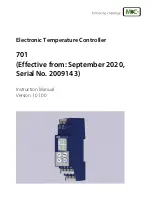
Installation Leaflet
Page 19 Effective: November 2002
Pow-R-Command
JCI-100 Controller
IL01412006E
For More Information visit www.cutler-hammer.com
APPENDIX C: TROUBLE SHOOTING
This Appendix will present a few examples
of problems that may be encountered under
normal operating conditions. This is by no
means and exhaustive technical study in
troubleshooting, but rather a helpful aide in
diagnosing, reporting, and remedying
common problems. Each title represents a
condition and following is a discussion of
the cause and cure.
C-1 BEFORE YOU BEGIN
Before following any of these procedures it
is a good idea to have a list of the loads in
the panel. This list should label breaker
assignments by assigned group and lighting
responsibility. For example: Breaker # 1,
Group #3, and Sign Lights. With this detailed
information verification of wiring and
programming will be greatly simplified.
---WARNING----
For safety, most of these procedures
require the panelboard or load to be
de-energized at the source. Conse-
quently there will be no lighting! Be
sure to follow these procedures ONLY
when it is safe to do so and will not
affect the safety of yourself or others.
---WARNING---
Some of the procedures in this
SECTION of the document require work
near parts caring high voltage. When
working near parts that carry high
voltage, remove power to the panel at
the main device before preforming
actions given in these procedures.
Failure to remove power at the main
device may result in severe personal
injury or even death.
C-2 LIGHTS FAIL TO COME ON
This is a very broad problem statement with
several possible causes. Each major area of
trouble is listed here.
1. The controller power is off or
disconnected. Make sure the Power LED
is in “On.” If it is “Off”, check the RED
Secondary Power Switch located below
the JCI100 Controller. The Secondary
Power Switch should be depressed to the
“On” position. If the switch is “On” and
there is still no power the following
procedures are best left to qualified
service personnel. Remove and check
the controller chassis fuse behind the
power-supply cover in the 5X Control
Box. Replace the necessary fuse as
described in SECTION 2-3-1 of this
document. If the problem still persists,
check to make sure that the entire
panelboard has power. The JCI100
draws its power indirectly from the bus.
If the entire panel does not have power
then the JCI100 will not. The above
mentioned procedures additionally apply
to both the control cabinet and the relay
cabinet. However, in both structures the
fusing is not concealed.
2. The Smart Breaker Main handles are in the
“Off” position. If the Smart Breakers are
making a clicking sound as if they are
switching “On” & “Off” then check to
make sure the Main Handles of the Smart
Breakers are in the “On” position. If the
Main Handle is left in the “Off” position, the
remote operation portion of the Smart
Breaker will function, but electrical flow
will not be present.
3. The JCI100 is improperly addressed at
either the device or at the Metasys
workstation. To determine this, please
check both the JCI100 address and the
address corresponding in the Metasys
workstation. If these addresses do not
match, there will be no communication.
This also includes making sure that each
JCI100 has a unique address on the
entire
Metasys network
4. Network connections are improperly
made. Remember that the shield
conductor carries a reference voltage,
and so it must not be grounded. At the
network connection check to make sure
that both the polarity is correct, and that
the shield conductor is not grounded.
5. The situation could be the lights in
question are not wired to Smart Breakers.
Consult your panel schedule and your local
Cutler-Hammer Representative if this is
suspected.
6. Malfunctioning BTB. If there is power to
the JCI100 Controller, indicated by a
illuminated Power LED, and the Smart
Breakers are not working a bad BTB may be
the problem. If the Smart Breakers on one
side of the panel are working but none of
the Smart Breakers are working on the
opposing side, then there is a bad BTB.
Contact your Cutler-Hammer representative
for assistance. If the Smart Breakers on
both sides of the panels fail to work either
both BTB’s are malfunctioning, or the RIB is
malfunctioning. In either case a check to
make sure all connection are solid. If
problems persist contact your local Cutler-
Hammer representative for assistance.
7. Malfunctioning Smart Breaker Pigtail. This
is only relevant when using type GHBS
Smart Breakers. As discussed in , the pigtail
for a GHBS is a separate component. A bad
pigtail is indicated when all of the Smart
Breakers in a group are working properly
with the exception of the suspected Smart
Breaker. To identify if this is the problem
remove a pigtail from another Smart Breaker
that is known to be working and connect it
to the suspected position. Cycle the group
that the suspected bad pigtail is in. If the
problem still persists the problem is not the
pigtail.
8. A malfunctioning Smart Breaker. If a
group seems to be working properly with
the exception of one or two Smart Breakers,
the Smart Breaker itself may be malfunction-
ing. To diagnose this problem, remove the
suspect Smart Breaker and replace it with a
Smart Breaker that is known to be working.
If the Smart Breaker that is known to be
working continues to work in the place of
the suspect Smart Breaker, the suspect
Smart Breaker is malfunctioning. Contact
your Cutler-Hammer representative for a
replacement Smart Breaker. If the Smart
Breaker that is known to work does not
worked when moved to the new pole
position, the BTB or pigtail may be malfunc-
tioning (See Above).



































